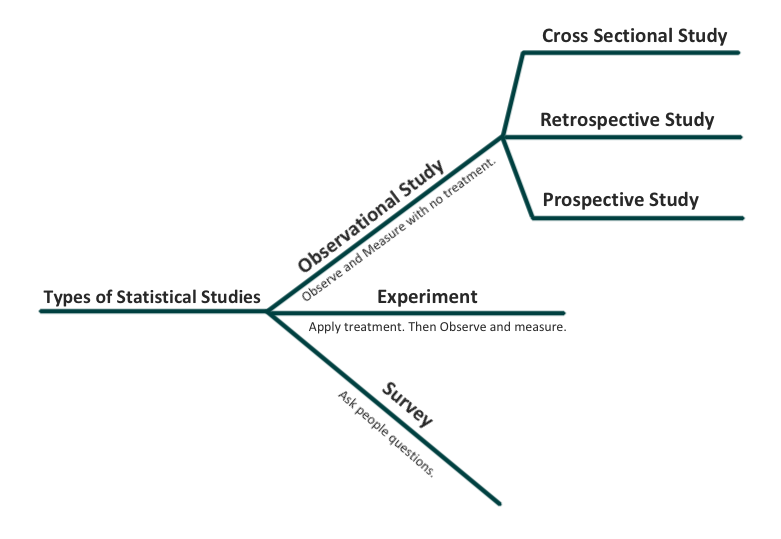LESSON: Observational Studies vs. Experiments
| Site: | Mountain Heights Academy OER |
| Course: | Introductory Statistics Q1 |
| Book: | LESSON: Observational Studies vs. Experiments |
| Printed by: | Guest user |
| Date: | Sunday, 27 July 2025, 6:07 AM |
Data Collection Methods
There are many ways one can collect data in statistics. We just finished learning about one method, which was through surveys. Surveys are a great way to investigate characteristics of a population. Most often, surveys are conducted by asking people questions.
Sometimes though, surveys don't answer the questions we have, so we have other methods of collecting data to help us. The following are two more ways we are going to learn about for collecting data:
Observational Study: In an observational study, a researcher observes, measures and records characteristics of interest of part of a population but does not change any existing conditions. The researcher is simply observing.
Experiment: When performing an experiment, a treatment is applied to part of a population and then responses are observed, measured and recorded.
Watch the video below to see an example of an observational study and an experiment.
Observational Studies
In an observational study, a researcher observes, measures and records characteristics of interest of part of a population. It's easy to think that an observational study only takes place when a researcher is watching something happen in front of him/her. But that's not the only way we can observe.
Here are three ways observational studies can take place:
Cross Sectional Study: Data is observed, measured and collected at one point in time. For example, a researcher observes how many people stop to buy concessions at a movie theater.
Retrospective Study: Data is collected from the past by going back in time (through examination of records, interviews, receipts etc.) For example, a researcher observes how many people stopped to buy concessions at a movie theater in the last month by reviewing receipts stored on the cash registers.
Prospective Study: Data is collected in the future from groups (called cohorts) sharing common factors. For example, a researcher may follow the spending habits of a group of people who frequent the movie theater to see if they will continue buying concessions in the future.

Experiments
A researcher conducts an experiment by applying some treatment to part of a population and then responses are observed and recorded.
For example, a researcher gives people walking into a movie theater a gift card with $10 on it. Then the researcher observes how many of those people use their gift card to buy concessions. The treatment in this example is the $10 gift card. The researcher wants to know what affect it will have on movie go-ers.
Sometimes, to better observe a population a researcher will divide them into a control group and a treatment group (sometimes also called the experimental group). The control group in the experiment has no treatment applied to it while the people in the treatment group do receive the treatment. In many cases, subjects in the control group may even be given a placebo. A placebo is a harmless, unmedicated, neutral treatment that is made to look like the real treatment. The responses of the control group and the treatment group can then be compared and studied.
For example, an experiment was conducted in which diabetes patients took cinnamon extract each day while a control group took none. After 40 days, the diabetes patients who took the cinnamon extract each day had reduced their risk of heart disease while the control group had experienced no change. By conducting the experiment in this way it was possible to conclude that taking cinnamon extract had a positive effect in reducing heart disease in diabetes patients.

Key Elements of Experiment Design
There are a few key factors to consider when designing and identifying good experiments.
Control: Experiments can get complicated very quickly. That's because there are so many variables to consider! Control means the researcher has done their due diligence to control the effects of all the different variables in the study. The goal is to isolate the single variable in question.
Replication: Replication refers to the practice of testing the experiment on a large enough sample from the population. In general, the larger the sample size, the more accurate the results of the experiment are for the population.
Randomization: Just like it was important in surveys to gather a random sample from the population (through methods like SRS, stratified sampling, cluster sampling etc.), it's also equally important in experiment design.
We'll talk more about the features of good experiment design more in the upcoming lessons.

